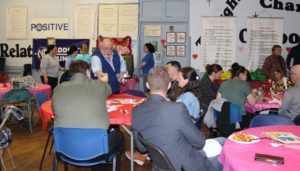Homelessness can be ended and it can be ended in New Bedford.
That’s the message Julia Orlando, director of a 27,000 square-foot low-barrier, comprehensive shelter in Bergen County, N.J., delivered in her Feb. 16 presentation at the Whaling Museum in New Bedford. Orlando successfully led the New Jersey coun-ty’s work to end homelessness and become the first in the nation to reach functional zero for chronic homeless-ness – meaning homelessness for this population is rare and brief.
Speaking before an audience of more than 100 people, Orlando was clear that Bergen County’s process wasn’t easy. It raised anxiety for many in the
Housing first, in part, means letting go of official rules to accessing housing in order to more fully include people sometimes considered difficult. “Difficult” individuals can be those who are addicted to substances, have criminal records, mental health problems, don’t meet qualifications such as having been homeless for a specific length of time, or won’t follow rules.
Housing first also starts with listening to the people who are in need of housing, Orlando said, calling respecting “lived experience” an important best practice in any homelessness solution.
“This is not about fixing people. This is about ending homelessness,” she told New Bedford professionals. “These folks are not going to change their behavior to meet your goals.”
Orlando led city officials, social service professionals, volunteers and others in the audience through the process of creating an $11 million regional shelter with the goal of ending homelessness. Completed in 2009, the building is operated 24 hours a day, 365 days a year, with 76 beds (down from 90 pre-pandemic), an on-site nurse, three meals a day, shower facilities, laundry, storage, mail service, computers and phones.
The facility is impressive to look at, resembling a hotel from the exterior, a fact that drew criticism from many who felt it was too luxurious, Orlando said.
But it is still a shelter, she added. “Is it comfortable?” Orlando said. “No, it’s not…But it’s clean and safe and I think those are the two most important things.”
Orlando’s presentation was part of a day-long workshop put on by the New Bedford Health Department, Greater New Bedford Opioid Task Force, Homeless Service Provider Network, Steppingstone, The Bristol County Regional Alliance, and Rise Up for Homes.
Unlike other shelters, including ones in New Bedford, the Bergen County shelter allows people to stay all day. They can have three meals a day there, if needed. “Folks don’t have to get up in the morning and go someplace else,” Orlando said. “So people are not (moving about) in the community during the day. They might be, but they don’t have to be. That’s a key feature for us.”
Being able to provide beds as needed to those who are newly homeless requires moving people out of the shelter and into permanent housing regularly. The outflow of the shelter must match the inflow, Orlando said.
Guests are told when they arrive that their stay is temporary and they must work with services on a plan for long-term housing, Orlando said, adding, that it’s communicated regularly.
“That’s what we do. ‘(We say,) we’re so happy you’re here…but it’s not home. You’re leaving.”
In the early days of planning the shelter, Orlando said there was a lot of resistance to the county’s efforts. She spent years reaching out regularly to residents and the business community building support for the project, she said, looking for ways to connect, listen, and shift thinking around homelessness and people who are homeless.
“Every community believes if they build it, they will come and what I needed them to understand is they are already here,” she said. “People who pay rent and have jobs fall into homelessness…. Things happen to people and if you have a place that can respond to that, you can actually benefit your community.”
Once the shelter opened and began opening meals to the public, more people were in the building to see what homelessness looked like, a factor that contributes to better understanding.
“Every night different people from our community serve meals, not in the street, not in a park, in our building and every night a different group comes in and sees the face of homelessness. And you know what they see? Someone they went to high school with, or they see a neighbor,” said Orlando. “It changes the perception.”
Two groups that she personally struggles with most are young adults and older ones, Orlando said. She sees about two people over the age of 80 needing shelter every week, usually individuals who don’t need nursing homes but can’t afford assisted living residences.
“We need an answer for that and we don’t have one,” she said.
In her comments about New Bedford, Orlando was very positive about the work already being done. She noted several bright spots, including a community dinner for those who are homeless being held at PAACA the evening of the workshop and the city’s commitment to and success in getting veterans into housing.
“When our vets come home and they kiss the ground, they shouldn’t have to sleep on it,” Orlando said. “You are honoring the people who served our country in the most important way.”
Ultimately, New Bedford should focus on ending homelessness, Orlando said. “Not managing it — ending it — and that’s a different kind of work.”
She also stressed that communities still need more housing.
“Shelters are not the end game,” she said. “Shelter is temporary. Shelter gets people off the street and housing ends homelessness.”

Recent Comments